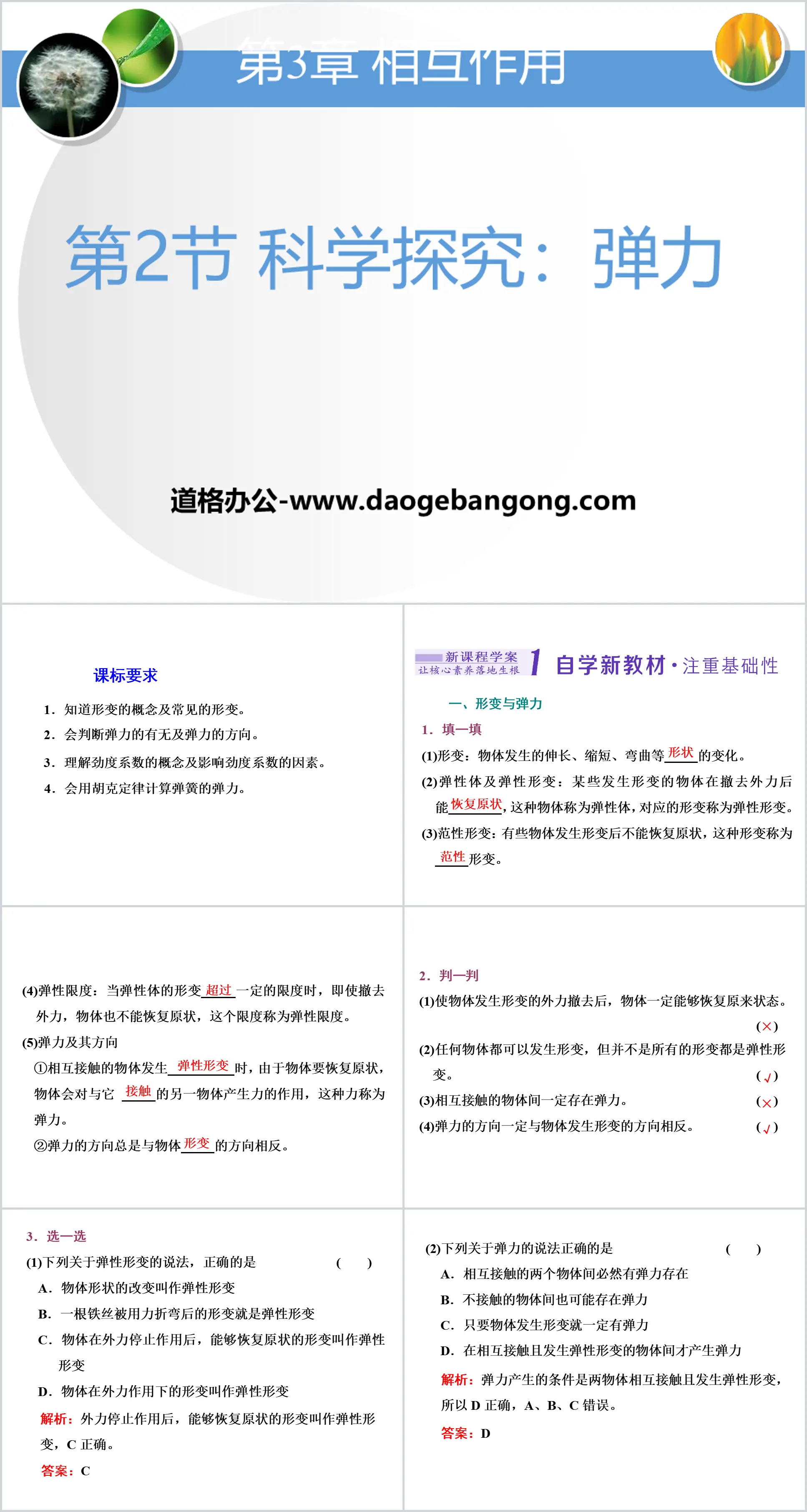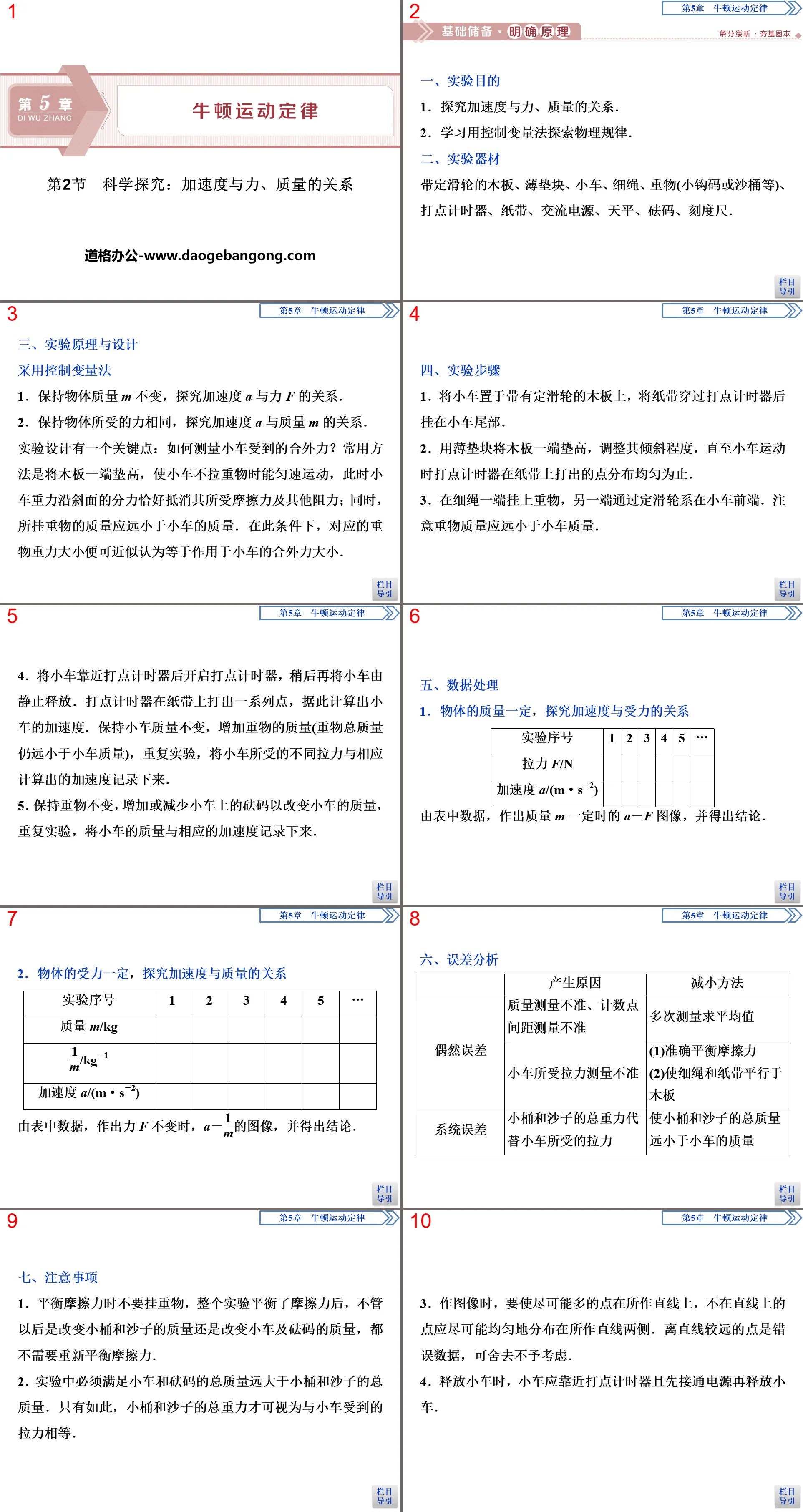"Scientific Inquiry: Elasticity" Interaction PPT Simple campus recruitment activity planning plan summary enterprise and institution recruitment publicity lecture PPT template is a general PPT template for business post competition provided by the manuscript PPT, simple campus recruitment activity planning plan summary enterprise and institution recruitment promotion Lecture PPT template, you can edit and modify the text and pictures in the source file by downloading the source file. If you want more exquisite business PPT templates, you can come to grid resource. Doug resource PPT, massive PPT template slide material download, we only make high-quality PPT templates!
| 文件名 如何下载使用 | 下载次数 | Download Points | 下载地址 |
|---|---|---|---|
| "Scientific Inquiry: Ela... | 23825次 | 0.00 | Free Download |
Tips: If you open the template and feel that it is not suitable for all your needs, you can search for related content "Scientific Inquiry: Elasticity" Interaction PPT is enough.
How to use the Windows system template
Directly decompress the file and use it with office or wps
How to use the Mac system template
Directly decompress the file and use it Office or wps can be used
Related reading
For more detailed PPT-related tutorials and font tutorials, you can view: Click to see
How to create a high-quality technological sense PPT? 4 ways to share the bottom of the box
Notice
Do not download in WeChat, Zhihu, QQ, built-in browsers, please use mobile browsers to download! If you are a mobile phone user, please download it on your computer!
1. The manuscript PPT is only for study and reference, please delete it 24 hours after downloading.
2. If the resource involves your legitimate rights and interests, delete it immediately.
3. Contact information: service@daogebangong.com
"Scientific Inquiry: Elasticity" Interaction PPT, due to usage restrictions, it is only for personal study and reference use. For commercial use, please go to the relevant official website for authorization.
(Personal non-commercial use refers to the use of this font to complete the display of personal works, including but not limited to the design of personal papers, resumes, etc.)

Related reading
For more detailed PPT-related tutorials and font tutorials, you can view:Please click to see










Authoritative PPT Summary
"Scientific Inquiry: Elasticity" Interaction PPT
Part One: Curriculum Standard Requirements
1. Understand the concept of deformation and common deformations.
2. It can determine the presence or absence of elasticity and the direction of elasticity.
3. Understand the concept of stiffness coefficient and the factors that affect stiffness coefficient.
4. Can use Hooke's law to calculate the elastic force of a spring.
Scientific exploration of elasticity PPT, part 2: new self-study textbook
1. Deformation and elasticity
1. Fill it out
(1) Deformation: ____ changes in an object such as elongation, shortening, and bending.
(2) Elastomers and elastic deformation: Some deformed objects can ____ after the external force is removed. Such objects are called elastomers, and the corresponding deformation is called elastic deformation.
(3) Paradigmatic deformation: Some objects cannot return to their original shape after deformation. This deformation is called ____ deformation.
(4) Elastic limit: When the deformation of an elastic body reaches a certain limit, the object cannot return to its original shape even if the external force is removed. This limit is called the elastic limit.
(5) Elastic force and its direction
① When objects in contact with each other ____, because the object wants to return to its original shape, the object will exert a force on the other object that ____ it. This force is called elastic force.
②The direction of the elastic force is always opposite to the direction of the object ____.
2. Give a verdict
(1) After the external force that causes the object to deform is removed, the object must be able to return to its original state. ( )
(2) Any object can deform, but not all deformations are elastic deformations. ( )
(3) There must be elastic force between objects in contact with each other. ( )
(4) The direction of elastic force must be opposite to the direction of deformation of the object. ( )
3. Choose one
(1) Which of the following statements about elastic deformation is correct ()
A. The change in the shape of an object is called elastic deformation
B. The deformation of an iron wire after it is bent with force is elastic deformation.
C. The deformation of an object that can return to its original shape after the external force stops acting is called elastic deformation
D. The deformation of an object under the action of external force is called elastic deformation
(2) Which of the following statements about elasticity is correct ()
A. There must be elasticity between two objects that are in contact with each other.
B. There may also be elastic forces between objects that are not in contact
C. As long as an object deforms, it must be elastic
D. Elastic force occurs between objects that are in contact with each other and undergo elastic deformation.
2. Hooke’s law
1. Fill it out
(1) Hooke’s law
①Content: Within the elastic limit, the size of the spring elastic force F is proportional to the length x of the spring ____ (or ____).
②Formula: F=____.
(2) Stiffness coefficient
①The proportional coefficient k in the formula is called the stiffness coefficient of the spring. It is a physical quantity with a unit, the unit is ____, and the symbol is ____.
②The stiffness coefficient is related to factors such as ____ and ____ of the elastomer.
2. Give a verdict
(1) The greater the deformation of the object, the greater the elasticity. ( )
(2) The size of the elastic force is related to the size of the object. The larger the object, the greater the elastic force generated. ( )
(3) Within the elastic limit, the elastic force of the spring is proportional to the length of the spring. ( )
(4) Within the elastic limit, if the two springs are stretched to the same length, the elastic force must be equal. ( )
(5) From F = kx, we know that k = Fx, so the stiffness coefficient k is directly proportional to the external force F and inversely proportional to the deformation amount x. ( )
3. think about it
From June 2 to 3, 2018, the third leg of APCC•2018• (Star Chapter) "Dalian Jinyi Cup" Outdoor Archery Championship (Dalian Station) was held in the Sports Center. As shown in the picture, the athlete is shooting an arrow with a bow. What should he do in order to make the arrow shoot farther? From this, we can see what is the relationship between the size of the elastic force and the size of the deformation?
Scientific exploration of elasticity PPT, the third part: improving new knowledge
Breakthrough point 1: Judgment of elasticity and direction
[Learn thoroughly and apply it]
1. How to judge the presence or absence of elasticity
(1) Method 1: For situations where the deformation is relatively obvious, it can be judged based on the conditions under which the elastic force is generated: ① The objects are in contact with each other; ② Elastic deformation occurs. Both conditions must be met at the same time for elasticity to occur.
(2) Method 2: For situations where the deformation is not obvious, the hypothesis method is usually used to judge.
2. Elastic force directions of several common contact methods
[Typical Example 1]Draw a schematic diagram of the elastic force exerted on the object P at each contact point or contact surface in each picture as shown in the figure. In each picture, the object P is in a stationary state.
[ Analysis The inclined surface is upward; in C, points A and B are both spherical surfaces in contact with the plane. The elastic force should be perpendicular to the plane and must pass through the center of the sphere. Therefore, the elastic force direction of point A is horizontal to the right, and the elastic force direction of point B is perpendicular to the inclined surface and upward to the left. And they all pass through the center of the ball; point A in D is a point in contact with the spherical surface, and the elastic force should be vertical to the tangential surface of the sphere and upward obliquely, and must pass through the center of the ball O. Point B is a point in contact with the rod, and the elastic force should be upward perpendicular to the rod. A schematic diagram of the elastic forces they experience is shown in the figure.
[Regular method]
The idea of judging the direction of elasticity
Clarify the elastic force to be analyzed ⇨ Determine the force-exerting object ⇨ Analyze the deformation direction of the force-exerting object ⇨ Determine the direction of the elastic force
[Practice clearly]
1. In the following figures, there must be an elastic force between balls A and B ()
Analysis: In picture A, if ball A is removed, ball B is stationary, so there is no squeeze between A and B, that is, there is no elastic force between A and B. In picture B, if ball A is taken away, ball B will move to the left, so there is mutual extrusion between A and B, that is, there is elastic force between A and B. In picture C, if ball A is taken away, ball B will remain stationary, so there is no squeeze between A and B, that is, there is no elastic force between A and B. In picture D, it cannot be judged whether there is elastic force between A and B. Therefore option B is correct.
2. As shown in the figure, ball A is blocked by a vertical baffle on the slope and is in a stationary state. Regarding the elastic force on ball A, the following statement is correct: ()
A. Ball A is only acted upon by one elastic force, and the direction of the elastic force is vertical and upward.
B. Ball A is acted upon by two elastic forces, one horizontally to the left and one vertically inclined downward.
C. Ball A is acted upon by two elastic forces, one horizontally to the right and one vertically inclined upward.
D. Ball A is acted upon by three elastic forces, one horizontally to the right, one vertically inclined upward, and one vertically downward.
3. Please draw the elastic force on the rod or ball.
(a) The rod rests against the wall.
(b) The ball is suspended from a vertical wall by a thin string.
(c) Points 1, 2, and 3 may all be the center of gravity of the ball, point 2 is the center of the ball, and points 1, 2, and 3 are on the same vertical line.
Breakthrough point 2: Calculation of elastic force
[Learn thoroughly and apply it]
1. Calculation of spring force
(1) When the spring deforms, it must be within the elastic limit.
(2)x is the deformation amount of the spring, not the length of the spring after deformation.
(3) As shown in the figure, the Fx image is an inclined straight line passing through the origin. The slope of the image represents the stiffness coefficient of the spring. For the same spring, the stiffness coefficient is unchanged.
(4) From F1 = kx1 and F2 = kx2, we can get ΔF = kΔx, that is, the change in spring force ΔF is also proportional to the change in deformation Δx. This relationship can also be obtained from the Fx image.
2. Calculation of general elasticity
For the calculation of the elastic force of other elastic bodies except springs, it is generally necessary to rely on the physical laws followed by the object's state of motion. For example, when an object suspended on a vertical string is in a stationary state, the object is subject to the upward pulling force of the rope and According to the vertical downward gravity effect, according to the balance of two forces, it can be seen that the pulling force of the rope is equal to the gravity of the object.
Scientific exploration of elasticity PPT, part 4: training new literacy
1. STSE questions, reflecting active learning and application
Observe the tiny deformations of the tabletop through a plane mirror
As shown in the figure, two plane mirrors M and N are placed on a large table, so that a beam of light is reflected by the two mirrors in turn, and finally hits the wall to form a light spot. Press the tabletop between the two mirrors and observe the changes in the position of the light spot on the wall.
(1) In which direction does the light spot on the wall move?
(2) In which direction does the desktop deform slightly after being pressed?
2. Discover good classic questions and practice the classic questions so that one can be as good as ten
A classmate added a hook code under a vertically suspended spring and conducted an experiment to study the relationship between elastic force and spring elongation. He recorded the experimental data in a table. During the experiment, the elastic force never exceeded the elastic limit, and g was taken as 10 N/kg.
(1) Based on the experimental data, draw the Fx image of the relationship between the elastic force F and the spring extension x on the graph paper.
(2) Calculate the stiffness coefficient of the spring based on the Fx image.
Keywords: Free download of PPT courseware for compulsory course 1 of high school physics in Lu Ke version, scientific exploration of elasticity PPT download, interaction PPT download, .PPT format;
For more information about the "Interaction Scientific Exploration of Elasticity" PPT courseware, please click the Interaction ppt Scientific Exploration of Elasticity ppt tag.
"End of Chapter Review Lesson" interactive PPT:
"End-of-Chapter Review Lesson" Interactive PPT Part One: Consolidation Level Knowledge Integration [Core Quick Filling] 1. The concept of force (1)Vectorality: both ____ and ____. (2) Effect: Make the object ____, change the ____ of the object. 2. Gravity (1)Definition..
"Optimization Summary of this Chapter" Interaction PPT:
"Optimization Summary of this Chapter" Interaction PPT Integration Improvement Comparison of Three Nature Powers 1. Differences and connections between gravity, elasticity and friction Category Item Gravity Elasticity Friction Cause of generation Attraction of the earth Objects come into contact and undergo elastic deformation Contact objects..
"Experiment: Explore the relationship between the elastic force and elongation of the spring" Interaction PPT:
"Experiment: Explore the relationship between the spring's elastic force and its elongation" Interaction PPT Part One Content: [Learning Literacy Targets] Physical concepts: 1. Explore the relationship between the spring's elongation and its elastic force. 2. Learn to use lists Method, image method, function method processing experiment..